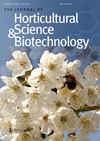外源施用水杨酸减轻菜豆(Phaseolus vulgaris L.)镉毒性的研究
IF 2.1
4区 农林科学
Q2 HORTICULTURE
Journal of Horticultural Science & Biotechnology
Pub Date : 2015-01-01
DOI:10.1080/14620316.2015.11513157
引用次数: 15
摘要
通过盆栽试验,研究了菜豆(Phaseolus vulgaris L.)在0.25和0.50 mM Cd2+污染培养基中对1.0 mM水杨酸(SA)的响应。播种后45 d取样植株进行生长测量和化学分析,并在每次试验结束时测量豆类产量。两种浓度的Cd2+均导致植物生长、色素浓度、相对含水量和营养物质浓度、叶绿素荧光(Fv/Fm)和光合作用性能指数(PI)显著下降。然而,1.0 mM SA减轻了Cd2+离子胁迫,并显著改善了这些参数。Cd2+离子处理均增加脯氨酸和Cd2+离子浓度、电解质泄漏和脂质过氧化(以丙二醛浓度测量)。然而,1.0 mM SA减弱了Cd2+离子对这些特性的不利影响。外源施用1.0 mM SA后,Cd2+诱导的几种关键抗氧化酶(如超氧化物歧化酶、过氧化氢酶、抗坏血酸过氧化物酶和谷胱甘肽还原酶)活性的增加减少。结果表明,施用1.0 mM SA可降低Cd2+对大豆植株的毒性。本文章由计算机程序翻译,如有差异,请以英文原文为准。
Alleviation of cadmium toxicity in common bean (Phaseolus vulgaris L.) plants by the exogenous application of salicylic acid
Summary A two-season pot experiment was conducted on Phaseolus vulgaris L. plants to evaluate their response to 1.0 mM salicylic acid (SA) in a growing medium contaminated with 0.25 or 0.50 mM Cd2+ ions. Plants were sampled for growth measurements and chemical analyses 45 d after sowing, and to measure the yield of beans at the end of each experiment. Exposing plants to either concentration of Cd2+ ions resulted in significant declines in growth, pigment concentrations, relative water content, and nutrient concentrations, and in chlorophyll fluorescence (Fv/Fm) and the performance index (PI) of photosynthesis. However, 1.0 mM SA mitigated Cd2+ ion stress and significantly improved each of these parameters. Both Cd2+ ion treatments increased proline and Cd2+ ion concentrations, electrolyte leakage, and lipid peroxidation (measured as malondialdehyde concentration). However, 1.0 mM SA attenuated the adverse effects of Cd2+ ions on these characteristics. Cd2+-induced increases in the activities of several key anti-oxidant enzymes such as superoxide dismutase, catalase, ascorbate peroxidase, and glutathione reductase were reduced following the exogenous application of 1.0 mM SA.These results confirm that the application of 1.0 mM SA could be used to reduce the adverse effects of Cd2+ ion toxicity in bean plants.
求助全文
通过发布文献求助,成功后即可免费获取论文全文。
去求助
来源期刊
CiteScore
3.90
自引率
5.30%
发文量
67
审稿时长
3 months
期刊介绍:
The Journal of Horticultural Science and Biotechnology is an international, peer-reviewed journal, which publishes original research contributions into the production, improvement and utilisation of horticultural crops. It aims to provide scientific knowledge of interest to those engaged in scientific research and the practice of horticulture. The scope of the journal includes studies on fruit and other perennial crops, vegetables and ornamentals grown in temperate or tropical regions and their use in commercial, amenity or urban horticulture. Papers, including reviews, that give new insights into plant and crop growth, yield, quality and response to the environment, are welcome, including those arising from technological innovation and developments in crop genome sequencing and other biotechnological advances.

 求助内容:
求助内容: 应助结果提醒方式:
应助结果提醒方式:


